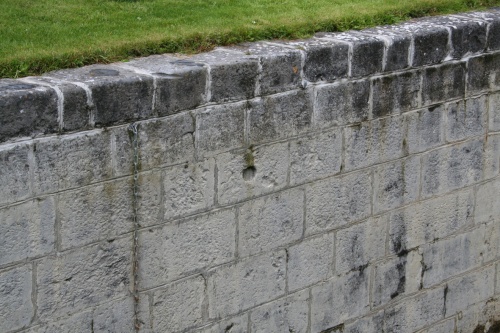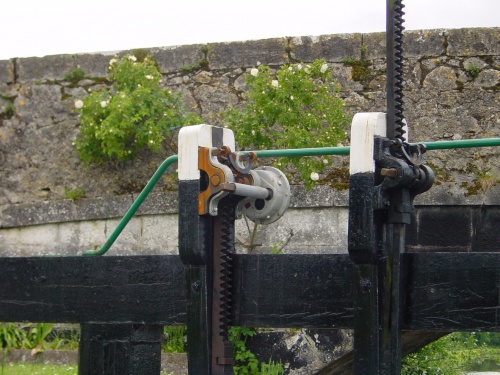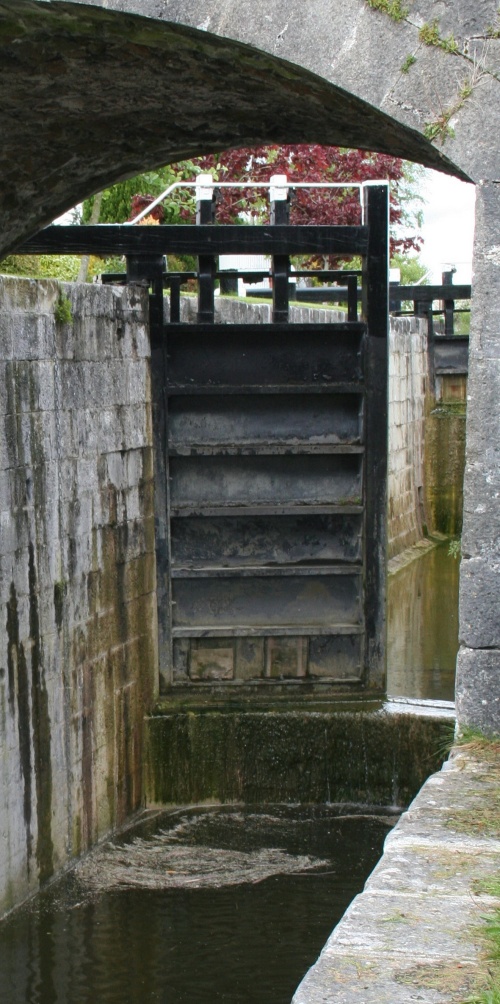I’ve described a lock on the River Shannon at Athlone on this page. The Shannon locks are probably the most-used locks in Ireland, as the vast majority of boats are based on the Shannon and the Erne, and the Erne has only one lock, at Portora, which is usually open at both ends. After the Shannon, I suspect that the Grand Canal has the next-most-used set of locks, so I’ll illustrate one of them here.
The Main Line of the Grand Canal runs from Suir Road Bridge, in Dublin, to the River Shannon. You can read about its original Main Line here. There are branches: the Circular Line runs around the south side of Dublin to Grand Canal Docks at Ringsend and thence to the River Liffey, the five-lock Naas Branch, the Barrow Line linking to the River Barrow at Athy, the somewhat navigable Milltown Feeder and some abandoned feeders and branches. The Grand Canal, the Royal Canal (being restored) and the River Barrow are controlled by Waterways Ireland’s Operations Eastern Region office.
The Main Line has thirty-six locks: eighteen take it up to its summit level at Robertstown and Lowtown and the other eighteen take it down to the Shannon at Shannon Harbour. There are no tunnels and no large flights of locks; however, there are five double locks (staircase pairs), four of them on the Dublin side of the summit and one, at Belmont, on the Shannon side. Double locks are generally counted as one lock in Ireland, and Belmont is therefore Lock 33.
Belmont Lock
Belmont Lock
The first time we went on the Grand Canal, starting from the Shannon in a GRP cruiser, we were warned that The Dreaded Belmont Double-Lock was greatly to be feared, as it was not only a double lock but also one with a bridge across the lower chamber, making it impossible to get a bow rope to a bollard on shore or to pull the boat into the upper chamber from the lower. However, a helpful lockkeeper makes it easy. Nonetheless Belmont is not typical of Grand Canal locks, but it shows a good range of features and lock furniture. And it’s very clean (has Waterways Ireland scrubbed it recently?) so the details show up well.
Belmont from below
The building on the left was a grain store: grain from Alberta or Argentina was shipped to Dublin, then carried by canal to this store and conveyed from there, by donkey and cart, to the large Belmont Mills a short distance to the north (which is to the left of this photo). You can see the landing place on the right, the bottom gates and the bridge across the lower chamber.
Here is the full upper chamber, taken from the bow of a boat about to enter the lock.
The full upper chamber
Note the footboards across the middle gates. Traditionally, the boards were hinged so that the back end of a boat could not get caught when rising in the lock. In some cases, the footboards are now fixed, thus reducing the effective length of the lock.
All Grand Canal locks are assigned to a keeper, with each keeper looking after several locks and driving between them in a small Waterways Ireland van. Some years ago, some keepers got quad bikes (ATVs), but they were withdrawn on safety grounds. Alan Wynne looks after Belmont and is both friendly and knowledgeable.
Some locks are kept locked (more on that below), which means that you must call the lockkeeper, but you can go through most locks by yourself if you want to. Keepers are on duty for long hours in the summer but much shorter hours in the winter, when their main concern is racking down water to manage the levels.
The stonework
Here is a photo looking down from the upper gates into the upper chamber.
The upper chamber
Note the round (almost oval) indentations in the next two photos. I had no idea what they’re for but Gerry Burke (68M) says:
These were put in the locks as grips for pushing out the horse boats with bargepoles.
Indentation 1
Indentation 2
The upper cill
The cill at the middle gates
There’s an interesting feature a little back from the gate.
Note that the gate swings in an area slightly lower than the main chamber floor
Here’s a photo looking down on that from above.
Isn’t that stonework lovely?
And look at the sharp edge of the gate recess
Looking from the lower gates towards the middle gates
The bridge
The bridge over the lower chamber
The under-side of the bridge
The parapet of the bridge
Belmont’s Tidy Towns award
The racks (paddles)
The maximum dimensions of vessels that Waterways Ireland allows on the canal are 61′ by 13′, although most locks are somewhat longer. The last three motor-barges built for the Grand Canal Company (77M to 79M) were 61′ 9″ by 13′ 3″.
Most Grand Canal locks (or least most I’ve noticed) have two land-racks (ground-paddles) and four gate-racks (gate-paddles). None of them have single gates. All are operated manually.
Land-rack
In general, users are advised to use the land-racks before the gate-racks. However, some keepers, especially in areas where the citizenry use the canals as rubbish-bins, prefer not to open the land-racks, lest rubbish should get in, jam the mechanism and make it impossible to close the racks again.
Land-rack mechanism
Where the land-rack sluice enters the lock
Here you can see a set of gate-racks. These all have the conventional spindles. You can see that one rack is up. Incidentally, the practice in Ireland (unless otherwise instructed, or unless another boat is coming) is to leave a lock with the upper gates and racks closed; the lower gates may be either open (if your boat went down) or closed with a single rack raised to drain the lock.
Gate-racks on the bottom gate
Here is a close-up of two racks, with the pawls visible. As far as I can recall, there is no Grand Canal lock with the sort of long spindle that can be operatedfrom the bank.
Close-up of the gate-racks
In some areas, Waterways Ireland has installed shrouded spindles to prevent yobboes with vice-grips from operating the racks. Here’s one of those spindles, at Lock 28 near Tullamore. This photo was taken with the flash on, so that the spindle could be seen inside the shroud.
Shrouded spindle
Shrouded spindles on both gate-racks and land-rack at Lock 28
These spindles require the use of a different lock key (note: not “windlass”). The traditional type is uppermost in the photo below, but the lower type is required to get through locks with shrouded spindles.
Lock keys
However, on the outskirts of Dublin, Waterways Ireland has had to go even further, installing locking mechanisms to which only keepers have keys. These mechanisms are extraordinarily awkward to operate.
Locked spindle
Note the metal box on the side opposite to the spindle. There is a padlock in there, holding in place a T-shaped pin that locks the rack in place.
The head of the T
The keeper has to lie or squat on the footboard and put one hand up into the metal box to undo the lock, then get around to the other side to remove the pin, and then reverse the process when locking is completed. This is a very time-consuming process, which delays the boat’s excape from bandit country.
Finally, Locks 28 and 29 had gears fitted to some racks, to make life easier for a (now retired) lockkeeper. They were still fitted in 2008. They took for ever to operate. (Thanks to Gerry Burke for the update on this.)
Geared rack
Back to Belmont. You can see the paddles on one of the middle gate in this next photo, and you can just about see one on the upper gate as well.
Paddles
The flow of water
If all six racks are opened, there is a considerable flow of water into the lock. Here is a narrowboat rising in a lock near Dublin, with just one gate-rack in use but with water coming over the gates as well.
Going up
And here are two racks up at Lock 9, filling the chamber for the next boat down.
Two racks up
Maelstrom
At double locks, lockkeepers (like their French counterparts) often leave the middle gates open until the water is deep enough for the boat to proceed into the upper chamber. I have no photo of that happening at Belmont, so here are two of the process at Lock 24 (Macartney Bridge) on the Barrow Line. (The Tuesday Night Club has a good series of Belmont pics here, starting about half way down the page.)
Filling Lock 24 Barrow Line 1
Filling Lock 24 Barrow Line 2
Chris Moss has made an important point about Belmont:
Enjoyed your pics of Belmont locks. But there’s one instruction that people used to British double locks might find useful.
If you are in an Irish double lock, it’s the common practice to keep the middle gate open until the bottom chamber is filled (or emptied if you are going down). At Belmont this is rather important as the gate racks (paddles) are set high up, such that if you are rising then the boat will be flooded with the arc of water coming out.
When we came up (in February) the lockkeeper wasn’t around — though we actually met up with him at the next lock — and having tried to ascend with the middle gates closed, we had to retreat, and empty the top lock entirely before proceeding.
Bollards
British Waterways has been criticised recently for installing three wooden bollards on each side of many locks. Admittedly square-sided bollards were probably a bad idea, but Irish boaters would not be surprised to find three bollards per side. Stop-ropes were used to slow and stop horse-drawn boats in the locks; when the Bolinder engine was fitted, the bollards remained in use: the Grand Canal Company motor-barge was kept running, so that the engine would not stall, with the boat held back by an 80-foot stop-rope around the bollard.
Here is Belmont’s upper chamber, with three bollards per side. Proper order.
Six bollards
And you can see that the lower chamber would have six but for there being a bridge in the way.
Four bollards
Most boats don’t use ropes when going downhill (although the skipper has to remain alert to stay clear of the cill). Going uphill, the absence of the forward pair of bollards on the lower chamber is not a disadvantage to a boat using a stop-rope. Such a boat lies along one wall, with a rope from the bow to a bollard behind the boat, motoring gently ahead while steering slightly away from the wall (which keeps the stern along the wall). But a boat that is used only to Shannon locks, with a bow and a stern rope around bollards ashore, will find a problem.
The gates
Here are some photos showing the gates and their beams.
The middle and upper gates
Lower gate beam. Note the handle on the end for pulling it from open to closed. The people in the background are members of the Industrial Heritage Association of Ireland
Middle gate beam. Note the curved stone path: such provision is not common at Irish locks. The black post with the icon of a walker shows that the canal bank is part of a long-distance walking route, the Grand Canal Way
Belmont Bridge has not been widened, but some bridges elsewhere, especially in Dublin, have been, and the gate beams have had to be shortened. Waterways Ireland (and its predecessors) usually resorted to the installation of very slow winches, as here at Lock 9 in Dublin.
Lock 9 winches
A close-up of the winch gear
Back to Belmont.
The lower and middle gates. The main body of each gate is made of galvanised steel, with wooden surrounds made of ekki (a hardwood). Almost all Grand Canal gate beams are wooden
Note the groove, presumably for stop-planks.
The groove
You can just about see the gate collar here
The lock surrounds
Here’s a view from the bridge, looking downstream.
Looking downstream from the bridge
Here’s another view of that interesting curve on the left. The landing-quay might be described as Middle Period.
The curve
You can’t get directly from the quay to the lower gate up the lock wing wall: a fence blocks access.
The fence
You have to walk up the track and enter the little area you saw the IHAI people in earlier.

Steps down to the lock-operation area
There is a similar area on the far side of the lock.
The lock-operation area on the opposite side
Access is between the grain store and the bridge …

… down the steps …
… and along this path.
Above the lock, the north bank has Old Style provision for mooring …
North Bank mooring bollards
… while the south features a modern wooden quay, presumably to be used only while the lock is being operated.
South Bank quay
The buildings
There are buildings on three of the four corners of the lock. You’ve already seen the grain store on the north-west corner; here it is again.
Looking towards the grain store
The plain front
Behind the store are two more buildings, which may be used for boat repair or sales.
Behind the grain store
On the north-east corner is what may have been the lockkeeper’s cottage. (Gerry Burke points out that all Grand Canal lockhouses were on the north bank.)
Possible lockkeeper’s cottage 1
Here’s another view of it, from the bridge.
Possible lockkeeper’s cottage 2
The south-east corner has both pleasing buildings and eyesores.
Attractive buildings
Not. Given that the rest of this lock and its surrounds are so attractive, couldn’t something be done to improve this lot?
What we didn’t see
Ladders. Most locks on the Grand, Barrow and Royal don’t have them: in fact, the last time I looked, only one lock on the three waterways had a ladder. Although lockkeepers are helpful, the absence of ladders makes single-handing difficult and may also reduce safety. There are chains in the chambers, but they’re for boats rather than for acrobatic boaters.
Bywashes.
Anything else? If you think of any aspect that hasn’t been covered, do please leave a Comment below.
I intend to do a separate page later about other features of the Grand, including some of the unusual lock shapes. I’ll also be covering some aspects of the use of locks and some waterways that have different types of gates and gear. However, it will take me a while to get around to all of that.
If you would like to be informed of new pages and significant amendments to this site, do please sign up to the RSS feed on the front page. You’ll get a brief blog posting whenever anything is added, and the blog will have a link to the appropriate page.

























































Brilliant piece about Belmont – we went through the double lock only two days ago for the first time ( it was our first time on the Grand Canal ) and we loved every minute of it. Loved the whole lock experience, amazing technology. It was probably a good thing that we went through before reading how daunting it can be but have to say in all honesty it really was a breeze, we had a very helpful lock-keeper. Looking forward to more canal boating having only been on the Shannon till now.
Thanks for the comments, Pat. I hope my piece doesn’t scare anyone off: I was trying to give the sort of comment that was made to us before our first canal journey. Like you, we found a very helpful lock-keeper and we greatly enjoyed the experience — and we are now confirmed supporters of the canals! They do take a bit more work than the Shannon, but that only makes for a greater sense of achievement when you get somewhere, whether it’s Tullamore, Lowtown, Dublin or St Mullins.
bjg
hello,just a note to let you know that the 20th and 21st[if memory serves] locks on the barrow line at ballyteague have no land racks and lock 13 at lyons estate is a very odd shape.
.i dont know if you have covered it but the side chambers at ticknevin 20th[filled in],landenstown 17th[only recently filled in] and digby bridge 16th[intact] might make an interesting article.
excelent website….paul.[little eden]
Thanks, Paul. You’re absolutely right: there is much of interest along the Grand and its branches. I must put up more canal photos ….
IWAI Kildare Branch was doing some work on the side chambers some years ago, but I don’t know whether it was finished. Lock 13 was originally a large Thomas Omer lock, as were 11 and 12; 13 was later converted into a double. If I remember correctly, the upper chamber holds more water than the lower, so it is possible to flood the area if you’re not careful (I wasn’t there at the time and anyway nobody saw me).
bjg
Pingback: A Grand Canal lock: Belmont | Irish waterways history
hello, was just wondering if you have any idea where the grand canal locks were constructed and around what time period.